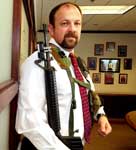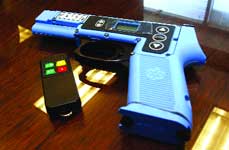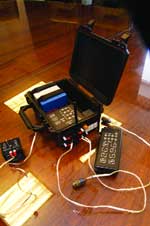Training market fires up

Demand for simulation technologies rises

Richard Arnold of the Army Laser Tag Training and Simulation System at Universal Systems and Technology Inc.
Rick Steele

Some of Unitech's virtual training products include a small-arms weapons trainer that shoots data-filled laser beams, and an improvised explosive device trainer.
Rick Steele

Any error in operating the equipment, a miscalculation of any kind could delay help or even thwart a much larger operation. When things go wrong on the battlefield, the quality of training becomes especially evident.
For today's network-centric military, with its missions that are all about teamwork, the latest training and simulation programs leverage computers and IT as never before. Computing power makes it possible to marry the real world with the virtual world in large-scale exercises.
As warfighting systems grow more complex, the opportunities around training and simulation will keep rising.
"The more the Defense Department continues down this path of developing new technologies to support the idea of network-centric warfare, then certainly we'll see more spending on simulation and training," said Payton Smith, an analyst with market research firm Input Inc., Reston, Va.
"The longer the military's involvement in Iraq lasts, the more spending we're going to see related to that type of warfare," Smith said. "If nothing else, Iraq is a test bed for some of these new technologies and tactics related to combating guerrilla warfare. And they require training."
Another factor driving development of training and simulation technology is the Pentagon's push for joint operations among the services. That push is expected to be even stronger in the future.
New recruits
Training that leverages IT begins at the entry levels of the services, said Richard Arnold, senior vice president of the training and simulation group for Universal Systems and Technology Inc., Centreville, Va. Unitech offers a wide range of training products.
"There will always be bread-and-butter training, teaching basic skills to folks as they come into the military and progress in their military careers," Arnold said.
Unitech has PC-based trainers for equipment such as generators, radios and heavy machine guns. Training on actual equipment is preferred, but computer-based training sometimes is more appropriate.
"It's super valuable for people when they don't have access to these bigger systems," Arnold said. "Any soldier or Marine can take machine gun training in the field or any place else they can get to a computer. They can even do it independently on their own."
Using a PC, a Marine deployed on a Navy ship can do refresher training to maintain the skills and knowledge associated with a piece of equipment, for instance.
"Am I going to replace going out on the range and putting rounds on the target? No," Arnold said. "But I can teach an awful lot of the skill sets and get a lot of knowledge across."
Using a computer keyboard and mouse, a soldier can learn how to operate a gun, how to adjust the sights and how to deal with a malfunction. Soldiers can see and move the individual parts and even hear the clicks associated with sighting a weapon.
"When a gunnery instructor saw this thing he said, 'Wow, you're teaching a real skill here,' " Arnold said.
All together now
Once basic skills are learned and perfected, technology is leveraged for team training. The trend is to combine actual training exercises with training in simulators, said Jerry Ehleiter, Anteon International Corp.'s group vice president of systems integration and training.
"For a while now, we've been working out of the Army's National Training Center, and what we've been able to do there is fuse live, virtual and constructive training to change the complexity of the training environment," Ehleiter said.
As big as the National Training Center in Fort Irwin, Calif., is, it's a tight fit when several units are there at once for training. Instead of jamming personnel into the center, staff create a constructive simulation that represents two sister brigades to a live brigade on the ground. That kind of exercise can help command and control training, without needing physical players sitting on the ground.
Using technology, all of the soldiers participating in a California training exercise don't have to be on-site. Virtual flight simulators in Fort Rucker, Ala., can be linked into a live and constructive exercise in at the National Training Center.
"You replicate in the flight simulator environments the same playing area, the same geographical space. So the guy flying in Fort Rucker in his flight simulator thinks he's flying in the National Training Center," Ehleiter said. "And he sees what's going on there; we constructively represent the forces on the ground."
If a column of tanks is live on the ground in California, the pilot in the Alabama simulator will see them.
The ability to combine the real world with the virtual world has opened up new training methods that at one time would have been too dangerous.
The ability to combine the real world with the virtual world also has opened up new training methods that at one time would have been too dangerous.
An Anteon lab in Orlando, Fla., leverages gaming technology and graphics to network two training houses for shooting exercises using live ammunition.
"The technology has allowed us to take the two shoot houses and put a soldier in one and another soldier in the other, and then virtually represent them in each other's space so they can interact with each other," Ehleiter said. "We can literally have a live player with live ammunition engage a live player with live ammunition in a duplicate building next door."
That trend of using gaming technology is likely to be a major growth area in the training and simulation space in coming years, Arnold said.
"We're constantly dealing with folks who come into the service at the entry level, and they've grown up with very robust technology," he said. "I'm not going to say that everybody who joins the military plays video games, but this generation is entering the services with different technology skills than previous generations did."
Staff Writer Doug Beizer can be reached at dbeizer@postnewsweektech.com.

